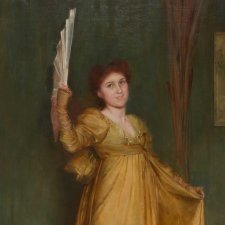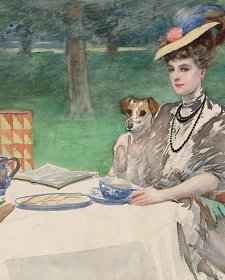Tom Roberts (1856–1931), artist, came to Australia from England at the age of 13, but returned eight years later to study art in London. He arrived back in Melbourne in 1885 and established a successful portrait practice. At the same time, he began to paint outdoors with a number of other artists, including Charles Conder and Arthur Streeton, and they came to be known as the ‘Heidelberg School’. In 1889 Roberts was an organiser of, and key participant in, the 9 by 5 Impression Exhibition in Melbourne. That year, intent on a series of paintings depicting quintessentially Australian scenes, he travelled from Melbourne to observe the action in the shearing shed on Brocklesby on the Murray near Corowa, New South Wales. There, over a few years he painted Shearing the rams and A break away. In 1891 he moved to an artists’ camp at Sirius Cove near Mosman, Sydney; he was to live in the city for twelve years. In 1892 he exhibited some significant portraits. Amongst them were Eileen and Aboriginal head (Charlie Turner), the first two of his pictures to be purchased for the Art Gallery of New South Wales; and also the trio ‘Church State and Law’, portraits of Cardinal Moran, Henry Parkes and Justice William Windeyer. (The location of the portrait of Cardinal Moran is one of Australian art's great mysteries.) Having completed his series of ‘Australian’ pictures with The Golden Fleece and Bailed Up by 1895, in the late 1890s he painted his series on wood panels of eminent Australians, amongst them many musicians and newspapermen; and also the remainder of his great portraits of women. Unsuccessful in his lobbying for the establishment of a national collection of portraits in the newly-federated Australia, he moved to England in 1903. In London, he completed his vast ‘Big Picture’ of the opening of the Australian Parliament, but the project was exhausting, his eyesight dwindled, and he fell into a black period as the success he had hoped for in the old country eluded him. During the First World War he understated his age to work as an orderly at the Third London General Hospital, Wandsworth. He returned permanently to Australia in 1923, settling at Kallista in the Dandenongs. There, he mostly painted small landscapes and flower pieces.
- About us
- Support the Gallery
- Venue hire
- Publications
- Research library
- Organisation chart
- Employment
- Contact us
- Make a booking
- Onsite programs
- Online programs
- School visit information
- Learning resources
- Little Darlings
- Professional learning













